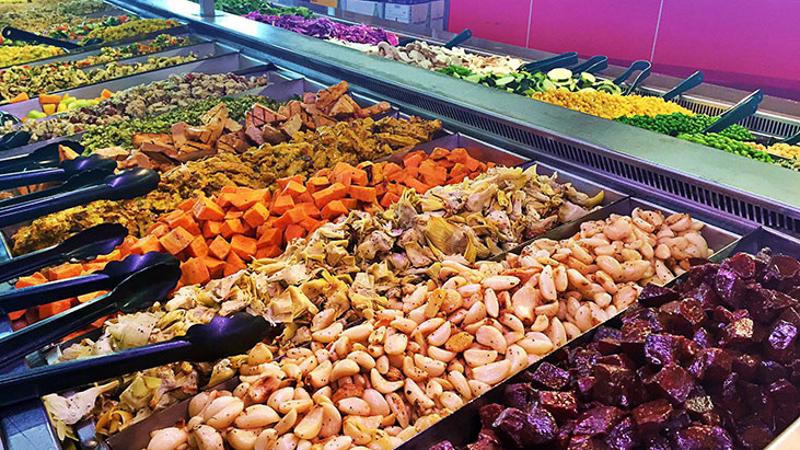
A couple of varieties of greens, some raw veggies, two or three kinds of salad dressings: That’s not enough for a salad bar anymore. Not when such concepts as Ruby Tuesday and 3 Greens Market are bringing extensive selections of cold and hot foods—from hummus to meatballs, prepared salads and multiple dressings and dips—to the table.
According to a recent report from Technomic, salad bars and other build-your-own concepts are a differentiator that appeals to many consumers—and especially to those earning $50,000 or more a year. In addition, 51 percent of consumers surveyed agreed with the statement “I would like more restaurants to offer a salad bar so I can create my own salad,” and 46 percent said they prefer to build their own salads as opposed to ordering one off of the menu. In both cases, this was particularly true for heavy salad users.
The salad bar has been around in the mainstream since the mid-1960s, with such brands as Steak and Ale and Richard Melman’s R.J. Grunts featuring all-you-can-eat assortments that set them apart from the rest of the fray.
But today, reinvented salad bars are more on-trend than ever, offering the ultimate in customization, value, fresh appeal and the ability to build repeat business to a new generation of experience-seeking diners. Well-outfitted salad bars allow guests to tailor a meal, appetizer or side dish to their individual tastes and dietary concerns, including the desire for healthier options and vegetarian or vegan selections. Then they can come back the next day and build a completely different salad.
That’s why such heritage concepts as Ponderosa and Bonanza are innovating around their salad bars, while newer fast-casual concepts Salata and Souplantation & Sweet Tomatoes are on a growth track. The trend also encompasses such brands as Sweetgreen, where salads are built to customers’ specifications from an on-view selection of different greens, toppings, condiments and dressings. Some are offered for a set price or included with an entree; others are paid for by weight.
Salad bars are also ideal for consumers who value food transparency—after all, it doesn’t get more transparent than building your own salad. Operators can even take transparency to the next level by offering fresher items and dressings with cleaner labels and no artificial colors or flavors to cater to the growing number of consumers who value real and natural ingredients.
Build a better salad bar
- Multiple kinds of greens, such as spinach and Romaine, as well as mixes including spring mix, and sturdier options such as red cabbage or radicchio
- A variety of different dressings, including gluten-free and light or low-fat—many of which, such as blue cheese, can also be used as dips for raw veggies and more. Be sure to offer both creamy and vinaigrette-style options, as well as a signature dressing or two, such as jalapeno ranch or strawberry poppy seed
- Trimmed raw vegetables such as carrots, cucumbers, tomatoes, mushrooms and other familiar varieties, as well as more unusual offerings such as jicama, avocado or sprouts
- Specialty items such as olives, kimchi and marinated artichoke hearts
- Prepared salads (bean and grain salads, potato salad, marinated veggies, pasta salad)
- Protein choices, such as hardboiled or even deviled eggs, crumbled bacon, chicken, tuna, tofu and tempeh, cheeses, smoked turkey and ham, chilled shrimp and more
- Dips including hummus, guacamole, salsa, veggie cream cheese or cucumber-dill Greek yogurt
- Fresh, canned and dried fruits
- Nuts and seeds
- Croutons and crackers, as well as sliced bread or crostini
- Beans and legumes (chick peas, black beans and so on)
- Hot items—anything from meatballs or baked pasta to fried chicken, mac-and-cheese, roasted vegetables, stuffed potato skins and ethnic items such as steak teriyaki or mini tamales
This post is sponsored by Litehouse Foodservice
